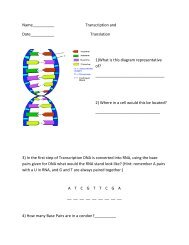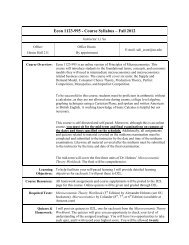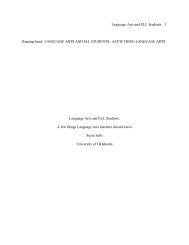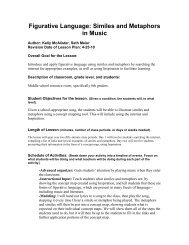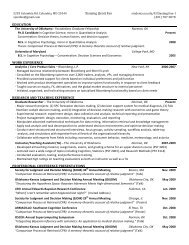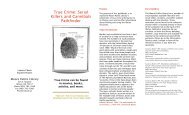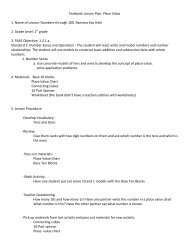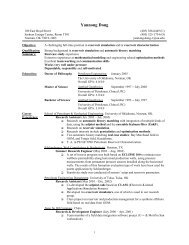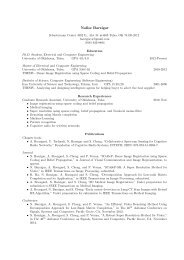Enhancing English Proficiency through TPR and Web-based ...
Enhancing English Proficiency through TPR and Web-based ...
Enhancing English Proficiency through TPR and Web-based ...
You also want an ePaper? Increase the reach of your titles
YUMPU automatically turns print PDFs into web optimized ePapers that Google loves.
<strong>Enhancing</strong> <strong>English</strong> <strong>Proficiency</strong> <strong>through</strong> <strong>TPR</strong> <strong>and</strong> <strong>Web</strong>-<strong>based</strong> Methods 2CONTENTINTRODUCTION 5NEEDS AND CONTEXT ANALYSIS 7BRIEF CONTEXT 7DISCREPANCY-BASED NEEDS ASSESSMENT 7GOAL AND GAPS 8PROBLEM-SOLVING 9CONTEXTUAL ANALYSIS 9INSTRUCTIONAL SOLUTION 10LEARNER ANALYSIS 12LEARNER CHARACTERISTICS 12GENERAL CHARACTERISTICS 12KNOWLEDGE 12SKILLS 13DEVELOPMENTAL STAGES 13EXPERIENCES 13MOTIVATION 14PERCEPTION 14DESIGN IMPLICATION 14GENERAL CHARACTERISTICS 14KNOWLEDGE 15SKILLS 15DEVELOPMENTAL STAGES 15EXPERIENCES 15MOTIVATION 16PERCEPTION 16TASK ANALYSIS 17PREREQUISITE ANALYSIS 18INFORMATION ANALYSIS 19
<strong>Enhancing</strong> <strong>English</strong> <strong>Proficiency</strong> <strong>through</strong> <strong>TPR</strong> <strong>and</strong> <strong>Web</strong>-<strong>based</strong> Methods 6readers. It allows students contact with the previous lesson that contain interactive activities,vocabulary, grammatical activities, <strong>and</strong> individual learning style <strong>and</strong> strategies. Theadvantage of an online lecture is accessibility <strong>and</strong> flexibility in terms of time <strong>and</strong> space.
<strong>Enhancing</strong> <strong>English</strong> <strong>Proficiency</strong> <strong>through</strong> <strong>TPR</strong> <strong>and</strong> <strong>Web</strong>-<strong>based</strong> Methods 7Needs <strong>and</strong> Context AnalysisFor a better job of planning instructional design, context analysis is important toclarify the problems <strong>and</strong> needs in the current environment. In this part, I will describe thegoal, the needs, the problem-solving <strong>and</strong> innovation.Brief ContextIn order to underst<strong>and</strong> <strong>and</strong> analyze the needs, I have researched information of 7 th<strong>English</strong> Education Curriculum <strong>and</strong> environment from Education Ministry data <strong>and</strong> The KoreaNational Statistical Office. Also, I surveyed three teachers <strong>and</strong> 34 3 rd grade students in publicelementary schools (see Appendix A, B). For more accurate measures of current situation <strong>and</strong>information, all teachers are working in different schools: Youndong, Guji, <strong>and</strong> Gwangjangelementary schools in Seoul, Korea (see Appendix C, D).For assessment, I will compare students’ oral achievement results with lastsemester’s (see Appendix K), <strong>and</strong> conduct surveys to teachers <strong>and</strong> students withquestionnaires (see Appendix G <strong>and</strong> H).Discrepancy-Based Needs AssessmentAccording to the Korean Ministry of Education, the emphasis should be placed oncommunication successfully <strong>and</strong> fluently when teaching <strong>English</strong>, rather than memorizing byrepetition. Since 2004, to try to improve communication skills, <strong>English</strong> has been taught inKorean elementary schools with the purpose of fostering students’ basic <strong>English</strong>communication competence in terms of usage in daily life, <strong>and</strong> increasing students’confidence in using <strong>English</strong>.The 7 th Amendment National Curriculum considers individual difference <strong>and</strong> task<strong>based</strong>education for communicative competence to foster logical thinking, critical thinking,
<strong>Enhancing</strong> <strong>English</strong> <strong>Proficiency</strong> <strong>through</strong> <strong>TPR</strong> <strong>and</strong> <strong>Web</strong>-<strong>based</strong> Methods 9• Textbook could not engage learners’ interestAlthough the curriculum emphasizes listening <strong>and</strong> speaking, writing also has to bepromoted for students’ language development. Based on current curricula of <strong>English</strong>education, offered 40 minutes <strong>English</strong> class per week, students need to have more time topractice <strong>and</strong> to study themselves. So, by providing web-<strong>based</strong> services, it allows students topractice the lesson at home <strong>and</strong> also use various levels of reading materials which includesound <strong>and</strong> video clips. This online-work <strong>and</strong> reading can help the development of <strong>English</strong>ability <strong>and</strong> enable students to become independent readers.The textbook does not reflect students’ oral <strong>and</strong> written language proficiency levels<strong>and</strong> interests because it is developed with the aim of targeting average elementary schoolstudents countrywide. This means that it could not meet the levels <strong>and</strong> interests of all studentsin a proper fashion. It could appear too easy <strong>and</strong> boring for some students <strong>and</strong> too difficult forothers. Consequently, it reduces the motivation of students to learn <strong>English</strong>. Therefore,effective teaching methods should be used to complement the textbook in order to engagestudents by meeting their level <strong>and</strong> interests.Problem-SolvingContextual AnalysisThe current <strong>English</strong> curriculum did not contribute to developing students’ oral<strong>English</strong> proficiency. Despite the predominant position in social status <strong>and</strong> facilities, thedegree of students’ reliance to <strong>English</strong> instruction in public schools is decreased <strong>and</strong> causedby the limitation of human <strong>and</strong> material resources of public school. Compared to privateinstitutes, the public <strong>English</strong> education environments are very limited: teachers’ lack ofspecialties in <strong>English</strong>, lack of training time, discrepancy in linguistic competence among
<strong>Enhancing</strong> <strong>English</strong> <strong>Proficiency</strong> <strong>through</strong> <strong>TPR</strong> <strong>and</strong> <strong>Web</strong>-<strong>based</strong> Methods 10students, <strong>and</strong> immoderate number of students per class.<strong>English</strong> elementary school teachers are not <strong>English</strong> majors. In addition, they teachseven to nine subjects. As a result, they highly depend on the textbook <strong>and</strong> have little time toexplore <strong>English</strong> activities <strong>and</strong> materials out of the curriculum. Teachers have difficulty inpaying attention to the <strong>English</strong> textbook <strong>and</strong> problematic curriculum. Thus, learning isinefficient <strong>and</strong> meaningless.The elementary <strong>English</strong> program is <strong>based</strong> on a textbook. However, the publicelementary <strong>English</strong> textbook does not provide enough authentic materials for students topractice various strategies to underst<strong>and</strong>ing meaning. Also, the textbook’s content, words <strong>and</strong>expressions often do not accurately reflect real-life situation. The information as provided inthe textbook often appears unnatural as it is used to describe actual situation. Therefore, it isdifficult for students to derive useful, meaningful content from it.Large elementary classes would make communicative language teaching difficult. Tocompensate for the large number of students <strong>and</strong> to promote the oral <strong>English</strong> program, thegovernment encourages the use of multimedia systems (VCRs, large-sized TV monitors, CD-ROMs) <strong>and</strong> has funded the installation of these systems in each class <strong>and</strong> school. There is theproblem in that watching video or CD-ROMs could bore the childrenInstructional SolutionTeachers’ training is required for the <strong>English</strong> course for learning the <strong>TPR</strong> method forcommunicative language teaching, <strong>and</strong> it could encourage teachers. Mostly, teachers cannotfocus on just the materials for <strong>English</strong> class because of their heavy workloads. If thegovernment develops a series of teaching materials <strong>and</strong> teachers’ guide books for <strong>TPR</strong>approach, teachers could manage class efficiently.Through <strong>TPR</strong> methods, such as sharing characteristic from cartoons or videos,students can underst<strong>and</strong> not only the story but also the words, gestures, <strong>and</strong> sounds easily.
<strong>Enhancing</strong> <strong>English</strong> <strong>Proficiency</strong> <strong>through</strong> <strong>TPR</strong> <strong>and</strong> <strong>Web</strong>-<strong>based</strong> Methods 11Also by using the guide book of the curriculum, elementary teachers can lead the classeffectively <strong>and</strong> clearly. Therefore, students could learn factual knowledge as well as buildmoral character. If a story is boring to an individual student, excitement of the activity canspread from one to another. By doing so, students have the chance to speak out in <strong>English</strong>without hesitation. Generally, young learners are very interested in stories, so students canconcentrate more on learning. Imitating the movements, students remember the storynaturally.In addition, students can correct themselves while observing other students’ responsewithout worrying about getting the right answer. It is good for reducing students’ anxiety, <strong>and</strong>makes more students relax <strong>and</strong> enjoy the class. Working with a group, like team <strong>English</strong>,encourages students to cooperate with each other. Students, in conjunction with their groupmembers, can waive the gap in their ability of <strong>English</strong>.<strong>Web</strong>-<strong>based</strong> learning helps to provide students practice with the lesson, as well as thevarious level of reading materials. Because of the limited time of <strong>English</strong> class in publicelementary schools, web-<strong>based</strong> learning enables students to become independent learners athome. By doing performance of the lesson as homework to parents, students can speak<strong>English</strong> in their daily life with fun. Also, by reading various materials <strong>through</strong> the web-site,students can build a positive <strong>English</strong> reading experience by addressing authentic language.
<strong>Enhancing</strong> <strong>English</strong> <strong>Proficiency</strong> <strong>through</strong> <strong>TPR</strong> <strong>and</strong> <strong>Web</strong>-<strong>based</strong> Methods 12Learner AnalysisThe purpose of learner analysis is to determine the current ability, knowledge, <strong>and</strong>skills of the learners.And it is identifying dominant learner characteristics <strong>and</strong> behaviormaking decisions about how to teach effectively. By analyzing learners’ characteristics, theinstructional designer can apply multiple methodologies in the course to appeal to thelearners.Learner CharacteristicsGeneral CharacteristicsThe target learners are thirty-four 3 rd grade public elementary school students locatedin Seoul, Korea. There were nineteen males <strong>and</strong> fifteen female students. All of them arenormal <strong>and</strong> very healthy with no problem on reading <strong>and</strong> listening.KnowledgeThe background information questionnaire (see Appendix A) was collected withquestions concerning student’s gender, extracurricular <strong>English</strong> learning, their first exposure to<strong>English</strong> learning, <strong>and</strong> self evaluation of their <strong>English</strong> proficiency. The questionnaires werewritten in Korean.According to survey, there was a huge gap among students in the class. Thirty two inthirty-four students know Alphabet: lowercase letter <strong>and</strong> uppercase letters. Only one studentscan make small talk with a native speaker, Sixteen students have no difficulty reading simplewords <strong>and</strong> sentences, fifteen students have a hard time reading text books by themselves, <strong>and</strong>two students did not know which is upper case or which is lower case in the Alphabet.
<strong>Enhancing</strong> <strong>English</strong> <strong>Proficiency</strong> <strong>through</strong> <strong>TPR</strong> <strong>and</strong> <strong>Web</strong>-<strong>based</strong> Methods 13Through <strong>TPR</strong> approach, this multilevel class can provide opportunities for students.Those with limited proficiency have an opportunity to interact with more proficient <strong>English</strong>speakers, <strong>and</strong> advanced learners benefit by using their <strong>English</strong> skills to help lower levelstudents negotiate meaning. Students in multilevel classes can learn to work together acrossdifferences <strong>and</strong> develop learning communities in which members learn from one another’sstrengths (Corley, 2005;Hofer & Larson, 1997; Jacobson, 2000; Wright, 1999).SkillsAs South Korea is recognized around the globe as one of the most Internet-savvynations, students had no difficulty to access the Internet, <strong>and</strong> they were used to playing theInternet game, on average, one hour a day.Developmental StagesIntegrating movement into the elementary school classroom can be effective in thedevelopment of <strong>English</strong> language proficiency for the learners. The brain learns best <strong>and</strong>retains most when the organism is actively involved in exploring physical sites <strong>and</strong> materials<strong>and</strong> asking questions to which it actually craves answers. Merely passive experiences tend toattenuate <strong>and</strong> have little lasting impact (Gardener, 1999). Through meaningful <strong>and</strong> funinteraction, the learners can develop the communication skills: decoding skills, fluency,vocabulary, <strong>and</strong> metacognitive thinking.3 rd grade students are incredibly energetic <strong>and</strong> active, <strong>and</strong> they enjoy being together.<strong>TPR</strong> method encourages students to participate in active <strong>English</strong> lessons in school. They haveprimarily same-sex friends, <strong>and</strong> friends assume greater importance to them.ExperiencesOnly one student had studied abroad for one year in the Philippines, others had had
<strong>Enhancing</strong> <strong>English</strong> <strong>Proficiency</strong> <strong>through</strong> <strong>TPR</strong> <strong>and</strong> <strong>Web</strong>-<strong>based</strong> Methods 14no experience of studying abroad. And all of them are native Korean speakers. Thirty onestudents have had the experience to take <strong>English</strong> lesson in various ways: going to an <strong>English</strong>institute, having private <strong>English</strong> lesson, or doing home-schooling. And twenty-four studentshave been taking the private lesson after school.MotivationAs parents focus more <strong>and</strong> more on the importance of <strong>English</strong> education to theirchildren, most of the students feel overwhelmed by pressure in learning <strong>English</strong>. However,students are highly motivated in learning language by movement. Also they are less afraid ofspeaking out in <strong>English</strong>. The students who started to study <strong>English</strong> before the 3 rd grade hadless anxiety <strong>and</strong> high interest about studying <strong>English</strong> than the students who started <strong>English</strong> inthe 3 rd grade.PerceptionStudents recognize that learning <strong>English</strong>, especially spoken <strong>English</strong>, is important toget the best careers <strong>and</strong> the best middle school or high school. Even thought they know theimportance in learning language, they are unsatisfied with their regular school <strong>English</strong> class,so, from the survey, 77 percent of students go to private institutions to study even more afterthe regular class of public school. In addition, they feel they can learn the subject matterbetter at private institutes.Design ImplicationGeneral CharacteristicsThirty-four 3 rd grade students in the survey were normal <strong>and</strong> healthy, no facilities <strong>and</strong>special materials are required in the project.
<strong>Enhancing</strong> <strong>English</strong> <strong>Proficiency</strong> <strong>through</strong> <strong>TPR</strong> <strong>and</strong> <strong>Web</strong>-<strong>based</strong> Methods 15KnowledgeThe ability in <strong>English</strong> has wide academic gaps among students in the class. So aninstructional designer should pay attention to apply proper materials, <strong>and</strong> to manage group forcollaborative learning, such as the students who are good at <strong>English</strong> can help the groupmembers study for the <strong>TPR</strong> activity in the class. In addition, by providing independentstudying <strong>through</strong> homework depends on student’s individual ability, each student can buildtheir knowledge not only in the class, but also at home.SkillsAll students can access the Internet at home, even at the school. Teachers should giveclear direction about their homework <strong>and</strong> home-activity. The one problem of 7 th <strong>English</strong>Curriculum in public schools is insufficient time for learning <strong>and</strong> practicing <strong>English</strong>. So,instructional designers should develop web-<strong>based</strong> learning programs which students canreview, practice <strong>and</strong> provide various materials by level. To check the students’ practice,parents’ help is also required.Developmental StagesNine year old children 3 rdgrade love physical activity, so they are easily intosomething which is more energetic, exuberant. When <strong>TPR</strong> approach is considered in <strong>English</strong>class, the instructional designer considers how to manage the large size of class moreeffectively to move around in the limited space. Also, the characteristic of 3 rd grade studentprefer studying with same-sex friends, a teacher should consider the gender <strong>and</strong> students’level when she or he divides students into groups.ExperiencesStudents have different prior knowledge in <strong>English</strong> depending on the experience inprivate institutes or by private tutoring. Although there is a gap in prior knowledge among
<strong>Enhancing</strong> <strong>English</strong> <strong>Proficiency</strong> <strong>through</strong> <strong>TPR</strong> <strong>and</strong> <strong>Web</strong>-<strong>based</strong> Methods 16students, an instructional designer should focus on the <strong>English</strong> educational goal for 3 rd gradestudents.MotivationIn the survey, students had interest in <strong>English</strong>, but they also got pressure from theirparents to achieve a good grade on <strong>English</strong> exams. So the instructional designers design <strong>TPR</strong>activities as well as other activities which are related with their lesson such as group role-playor game to engage students’ interest during the class.PerceptionTo change the students’ perception that public education systems are not trustable toimprove the language proficiency compared with private institutes, the instructional designerprovide various materials <strong>and</strong> web-<strong>based</strong> software. By using those materials <strong>and</strong> <strong>TPR</strong>multimedia system, the teacher teaches the <strong>English</strong> class in an interesting way, <strong>and</strong> studentscan have many chances for <strong>English</strong> education. This <strong>English</strong> education program may becarried out to narrow the gap in <strong>English</strong> education quality among schools <strong>and</strong> reduce privateeducation costs.
<strong>Enhancing</strong> <strong>English</strong> <strong>Proficiency</strong> <strong>through</strong> <strong>TPR</strong> <strong>and</strong> <strong>Web</strong>-<strong>based</strong> Methods 17Task analysisThe purpose of the task analysis is to design better instructions <strong>and</strong> the best plan forinstructions project being created in the time available not only in business, but also in class.Gagné's theories involved the information-processing model of cognition. He mentioned that"This model posits a number of internal processes that are subject to the influence of a varietyof external events. The arrangement of external events to activate <strong>and</strong> support the internalprocesses of learning constitutes what is called instruction" (Gagné, 1974). According toBrophy, students do not merely passively receive or copy input from teachers, but insteadactively mediate on it by trying to make sense of it <strong>and</strong> to relate it to what they already know(or think they know) about the topic. This project is <strong>based</strong> on a movement in psychomotorskills because students learn new knowledge <strong>through</strong> a process of active construction.The overall goal of the project is to improve <strong>English</strong> fluency of public elementaryschool students in four skills, listening, speaking, reading <strong>and</strong> writing skills <strong>through</strong> <strong>TPR</strong> <strong>and</strong>web-<strong>based</strong> method. I will analyze the task using Gagne’s theory. Three learning goals areidentified for this project.• Goal 1: Given a short <strong>English</strong> movie, the learners can identify the words, sentences,<strong>and</strong> content of the story by acting it out with words, gestures, <strong>and</strong> facial expression.• Goal 2: Given the words <strong>and</strong> sentences from the story from the E-book, the learnerwill be able to write a clear <strong>and</strong> simple sentence about the story.• Goal 3: Given a related question about the story, the learners are able to make a smallinteractive class discussion
<strong>Enhancing</strong> <strong>English</strong> <strong>Proficiency</strong> <strong>through</strong> <strong>TPR</strong> <strong>and</strong> <strong>Web</strong>-<strong>based</strong> Methods 18Prerequisite AnalysisThis project is intended for beginners. Basic knowledge <strong>and</strong> skills are required forthe instructions.• For the classroom-instruction- Identify twenty six letters of the <strong>English</strong> Alphabet Classify two different ligatures of the Alphabet• Uppercase/ Lowercase Read each letter name- Recognize phonetic features of the Alphabet Pronounce each alphabet Recognize vowel letters <strong>and</strong> consonant letters• Vowel letters• Consonant letters Recognize phonics patterns• Distinguish short vowels <strong>and</strong> long vowels• Identify consonant digraphs• For the online-instruction- Have basic computer skills: turn on the computer, typing on thekeyboard, Internet access, <strong>and</strong> control the mouse <strong>and</strong> speaker- Navigate a web browser- Log into the online lecture site- Make an ID <strong>and</strong> password to log-in
<strong>Enhancing</strong> <strong>English</strong> <strong>Proficiency</strong> <strong>through</strong> <strong>TPR</strong> <strong>and</strong> <strong>Web</strong>-<strong>based</strong> Methods 19Information AnalysisLearning outcomes describe skills, attitudes, <strong>and</strong> knowledge for learners’ completinglearning subjects successfully. Gagne organized learning outcomes in five categories: verbalinformation, intellectual skill, cognitive strategy, attitude, <strong>and</strong> motor skill. In second languageteaching instruction, the learners will concentrate more on:• Verbal information- Recognize new words <strong>and</strong> phrases- Identify syllable <strong>and</strong> lenis- Recall the knowledge of words, phrases, <strong>and</strong> sentences• Intellectual skills- Recall personal experience- Recognize processes <strong>and</strong> characteristic of letters- Classify construction of <strong>English</strong>- Comprehend the meaning of the content- Rewrite a very short story• Cognitive strategy- Discuss what the learners learned about the story• Motor skill- Act out the character’s gesture, tone, <strong>and</strong> behavior.
<strong>Enhancing</strong> <strong>English</strong> <strong>Proficiency</strong> <strong>through</strong> <strong>TPR</strong> <strong>and</strong> <strong>Web</strong>-<strong>based</strong> Methods 20The table below shows hierarchical relationship of information processing of the project inbrief.Table 1Information processing of the project*The component of Stage2 has creativity <strong>and</strong> problem solving activitiesThe lesson is to focus on improvement of learners’ language fluency. One in classlesson is focused on speaking -<strong>and</strong> overall underst<strong>and</strong>ing of the story. Considering themultilevel lesson, basic <strong>English</strong> skills need to be mentioned briefly in the beginning of theclass, such as recalling alphabet sounds <strong>and</strong> letters. Through recalling their personalexperiences which are related with the topic, the learners identify correlations between whatthey knew <strong>and</strong> what they will learn. Recognizing phonetics <strong>and</strong> concepts of new words,learners will comprehend new grammar structures of the context meaningfully. Acting thecharacters of the story while watching the movie will involve learners in how the words areused in the scenario of the movie, as well as regulate their thinking <strong>and</strong> help them remember
<strong>Enhancing</strong> <strong>English</strong> <strong>Proficiency</strong> <strong>through</strong> <strong>TPR</strong> <strong>and</strong> <strong>Web</strong>-<strong>based</strong> Methods 21the story. Furthermore, the learners will identify syllables <strong>and</strong> lexis <strong>through</strong> the performance,while trying to imitate the characters’ in the movie, such as intonation, pronunciation, rhythm,emotion <strong>and</strong> behavior. It also makes them recognize American culture indirectly.If classroom-instruction is concentrated on the learners’ oral practice, on-lineinstruction engages in comprehensive writing skills. Given the detailed explanation ofsentence structure in the flash file of the story, the learners recall the knowledge of words,phrases, <strong>and</strong> sentences. Also, by watching subtitles in the flash files, the learners not onlyrecognize processes <strong>and</strong> characteristics of letters, they also classify construction of <strong>English</strong>.Interaction with the concepts <strong>and</strong> events of the story helps the learner master the content ofthe scenario. At the end of the instruction, the learners comprehend the meaning of thecontent <strong>and</strong> briefly rewrite a story <strong>based</strong> on the lesson.After all these sequences are done, the learners are able to discuss <strong>and</strong> to share thestories that they learned for the lesson.This processing sequence mainly involves applying both declarative knowledge <strong>and</strong>procedural knowledge: knowing words, phrases, <strong>and</strong> sentence structures, <strong>and</strong> knowing how toapply these in real life.Subordinate Skills AnalysisSubordinate skill analysis is what the learners will need to know to be able toperform in each step. Gagne noted that the sequences suggested by hierarchies were paths thelearner could take to the final objective. Let’s take a look at some categories of outcomes <strong>and</strong>correlate them to instruction in more detail <strong>based</strong> on Gagne’s learning outcomes theory:
<strong>Enhancing</strong> <strong>English</strong> <strong>Proficiency</strong> <strong>through</strong> <strong>TPR</strong> <strong>and</strong> <strong>Web</strong>-<strong>based</strong> Methods 22Table 2Objective Statement of the ProjectInformation ProcessingSequenceSub-skillsPerformance-contentmatrix modelRecall the personalexperienceRespond to new words<strong>and</strong> phrases by actingoutDemonstrate very shortscenarios with bodymovementIdentify the correlation between thelearners' experience <strong>and</strong> the content-Cultural-Situational-PersonalIdentify new objectives-Meaning-Pronunciation-Synonyms <strong>and</strong> Antonyms-PhoneticsIdentify the characteristics of thecharacters in the story-Name-Character-Behavior-Gesture-StorylineDistinguish different pronunciation-Syllable-LexisRecallConceptConcept/ factPrinciples <strong>and</strong> Rules
<strong>Enhancing</strong> <strong>English</strong> <strong>Proficiency</strong> <strong>through</strong> <strong>TPR</strong> <strong>and</strong> <strong>Web</strong>-<strong>based</strong> Methods 23Recognize a grammatical rule naturallyMemorize lines by imitating thePrinciples <strong>and</strong> RulesAttitudeRetell the scenariosRecognize the contentof the storyRewrite the storycharacters in the story with-Tone-Gesture-Emotion-MovementCreate a new sentence by applying newwords.Classify the rule of grammar in content-Tense-FormRecognize detail information in thestory-Main event-Sequence of the eventsIdentify the events in chronologicalorderRespond appropriately to questions<strong>based</strong> on-Phrases that the learners learned-Content of the storyUse basic phrases in dialog formThink creatively to write a shortApplicationPrinciples <strong>and</strong> RulesFact/ ConceptFact/ ConceptAttitudeApplicationApplication
<strong>Enhancing</strong> <strong>English</strong> <strong>Proficiency</strong> <strong>through</strong> <strong>TPR</strong> <strong>and</strong> <strong>Web</strong>-<strong>based</strong> Methods 24sentence about the storyEnable to make a smalldiscussionRespond to the learner’s own idea about-the characters-the expressionApplicationThese learning outcomes help to determine class content for improving the <strong>English</strong>abilities of public elementary school students. Furthermore, <strong>through</strong> the st<strong>and</strong>ards of theoutcomes, the teacher can know what information <strong>and</strong> skills he or she attempts to teach in theclass.Sample assessment itemsThe project is to focus on the improvement of the 3 rd grader in elementary school oflistening, speaking, reading, <strong>and</strong> writing <strong>through</strong> both in-class lessons <strong>and</strong> on-line lessons.The assessment samples are explained in the table below:Table 3Sample of assessment itemsObjective Question Form Question CharacteristicsListeningGiven a listeningcomprehension test, thestudents can identify thewords <strong>and</strong> expressionsMultiple choiceEach picture presents a different meaning orsituation. Students identify correct answersafter listening to a short dialogue.After listening to a conversation, choose theright picturewhile they are listening todialogues12
<strong>Enhancing</strong> <strong>English</strong> <strong>Proficiency</strong> <strong>through</strong> <strong>TPR</strong> <strong>and</strong> <strong>Web</strong>-<strong>based</strong> Methods 2534SpeakingGiven an oral test, thestudents can reply with theright answers withappropriate acts in thegiven situationReadingGiven the movie, thestudents can identify themain event <strong>and</strong> thesequence of the eventsInterviewMultiple choiceDialogueA: Good morningB: Good morning, How are you?A: Fine, thank you.A teacher can check a student’spronunciation <strong>and</strong> comprehension of thecontent.T: Can you sit here?L: Yes, I can (sit on the chair)Interviewee: Can you point to the body partof this word? (show a word card)T: Yes, I can. (point the body part) Read, <strong>and</strong> choose the rightanswer.I have a long nose, big ears, <strong>and</strong> wrinkledskin. Who am I?1Monkey 2Graff 3Lion 4Elephant
<strong>Enhancing</strong> <strong>English</strong> <strong>Proficiency</strong> <strong>through</strong> <strong>TPR</strong> <strong>and</strong> <strong>Web</strong>-<strong>based</strong> Methods 26WritingGiven a question, thestudents can write downthe appropriate grammarformation in the blank.Short answerquestionA student creates a sentence after he or sheread a short scenario. After reading a short scenario,create a sentence with your own words.I am a penguin <strong>and</strong> I turn my head. Canyou do it? I can do it!I am a monkey <strong>and</strong> I wave my arms. Canyou do it? I can do it!__________________Number of Items <strong>and</strong> Mastery Criteria• The number of items is 24: 10 for listing, 10 for reading, 2 for writing <strong>and</strong> 2 forspeaking.• Mastery is the score of 70 or above from the test.
<strong>Enhancing</strong> <strong>English</strong> <strong>Proficiency</strong> <strong>through</strong> <strong>TPR</strong> <strong>and</strong> <strong>Web</strong>-<strong>based</strong> Methods 27Instructional PlanInstructional plan is to effectively organize instructional activities <strong>and</strong> materials. As Iexplained in the previous parts, the current <strong>English</strong> language education of Korea is in alimited environment- the 7 th <strong>English</strong> Education curriculum provides insufficient time <strong>and</strong>materials for students. Also it only focuses on building listening <strong>and</strong> speaking skills,excluding reading <strong>and</strong> writing. Reading <strong>and</strong> writing should be considered equally toimproving students’ oral language development. In addition, a huge gap of <strong>English</strong> abilityamong students <strong>and</strong> large class size are problems for solution.To improve the curriculum, this project applies Total Physical Respond <strong>and</strong> web<strong>based</strong>methods for balanced development in four skills: listening, speaking, reading, <strong>and</strong>writing. Image <strong>and</strong> sound effects, such as highlighting key expressions <strong>and</strong> grammar rules indifferent colors, are useful techniques for focusing attention in the lessons (Smith & Ragan,2005). Not only for getting attention <strong>through</strong> the effects, but also both reading the story ofmovie <strong>and</strong> extensive on-line reading supplements aroused students’ interest. The onlinelecture is an extended lesson, <strong>and</strong> will lead students to conduct objectives at home for selfpractice.Learning goals <strong>and</strong> Objectives• Goal 1: Given a short <strong>English</strong> movie, the learners can identify the words,sentences, <strong>and</strong> content of the story by acting it out with words, gestures, <strong>and</strong>facial expression. (Verbal/ Motor skill)Declarative knowledge: knowing “that,” <strong>and</strong> procedural knowledge: knowing “how,”are implied most in the first part of the lessons. The most vocabulary <strong>and</strong> phrases learningactivities are taught by <strong>TPR</strong> method. The learner level considered, <strong>TPR</strong> is applied in an
<strong>Enhancing</strong> <strong>English</strong> <strong>Proficiency</strong> <strong>through</strong> <strong>TPR</strong> <strong>and</strong> <strong>Web</strong>-<strong>based</strong> Methods 28attempt to lower level students’ burden of learning <strong>and</strong> to promote language acquisition byproviding a comfortable learning environment.Objective 1: Given a picture or questions relates with the contents, the learnersrecall their personal experience.In the beginning of the class, interesting supplement materials can gain studentsattention. To construct meaningful knowledge structure, new declarative knowledge shouldbe tied with existing knowledge to accumulate knowledge in a long-term. As students recalltheir personal experience to make connection with the task, ideas will enhance the quality ofthe lesson because students are able to brainstorm with classmates by given questions orpictures. It creates new ideas, <strong>and</strong> motivates students..Objective 2: Given picture cards, the learners are able to respond to new words <strong>and</strong>phrase them by acing it out.The teacher often uses picture cards to help to learners underst<strong>and</strong>ing <strong>and</strong> thepictures render the input as comprehensible as possible (Krashen, 2003). In addition to this,the teacher’s example movements provide the background knowledge that makes thecomm<strong>and</strong> more comprehensible. Those steps make students formulate in a series of rules ofthe content <strong>and</strong> knowledge, <strong>and</strong> involve in a situation where meaning of words isimmediately perceived <strong>and</strong> understood.Objective 3: After imitating characters in the story, the learners are able todemonstrate a very short scenario with movement.This stage is to provide as much comprehensible input as possible so that recall willbe promoted. The teacher uses short scenarios as a means of providing comprehensible input
<strong>Enhancing</strong> <strong>English</strong> <strong>Proficiency</strong> <strong>through</strong> <strong>TPR</strong> <strong>and</strong> <strong>Web</strong>-<strong>based</strong> Methods 29even though the students will not be able to underst<strong>and</strong> all the detailed contents. Furthermore,the teacher can repeat the scenarios again <strong>and</strong> again by using different materials or differentkinds of delivery, such as by changing actions, by asking questions, etc. Through repeatedactivity, students learn the content in long-term memory that is initiated by appropriate inputsautomatically without necessarily dem<strong>and</strong>ing attention (Schneder & Shiffrin, 1977),Objective 4: After watching the movie, the learners are able to retell the scenario.Create a new sentence by applying new words.By retelling the scenarios, cognitive strategies involves for re-conceptualization ofthe scenarios. Students can facilitate elements that they learned in the previous parts. If thestudents comprehend one well-learned language routines such as vocabulary, grammar rules,expressions, they can create a short sentence using appropriate words or phrases to describetheir thinking. When the teacher shows a content movie, the students’ responses are clueswhether they underst<strong>and</strong> the story or not.• Goal 2: Given the words <strong>and</strong> sentences from the story from the E-book, thelearner will be able to write simple sentence about the story clearly.(Intellectual/ Cognitive)Students are willing do individual work at home. Whole scenarios of the movie <strong>and</strong>related supplements with the topic of the lesson will be provided though the web. It is anapplied guided participation strategy <strong>and</strong> self-instructional training strategy. Explicit training,by offering supplement reading, makes students outperform the students who are beginninga use of a particular strategy (Weinstein, 1978). Moreover, the web-<strong>based</strong> intelligent tutoringsystem for metacognition improves learning from content (Puntambekar, 1995). The on-linereading’s multiple visual <strong>and</strong> audio representations helps students underst<strong>and</strong> <strong>and</strong> inspire
<strong>Enhancing</strong> <strong>English</strong> <strong>Proficiency</strong> <strong>through</strong> <strong>TPR</strong> <strong>and</strong> <strong>Web</strong>-<strong>based</strong> Methods 30motivation in reading.Objective 1: Given the whole story <strong>through</strong> E-book, the learners will recognize thecontent of the story /the Classify the rule of grammar, detail information in contentThe script from web provides the structure <strong>and</strong> organization to include contentinvolving <strong>English</strong> clearly. Given clues for cognitive thinking to guess the grammar rules <strong>and</strong>contents while reading, students can determine the characteristics of the contents bythemselves.Objective 2: Given a situation of the story, students are able to rewrite the storyusing basic phrases in a dialogue form.The rereading strategy is a useful pedagogical tool <strong>and</strong> has potential benefit forenhancing readers’ comprehension as well as enjoyment of literature (Faust & Glenzer. 2000).By providing E-story book, students are able to read a story more than once to enhance theirreading ability. After students’ comprehension of stories, students can build a sentence usingtheir own word applying the grammar rule of the lesson.Goal 3: Given a related question about the story, the learners enable tomake a small interactive class discussion (Cognitive).The active interaction with the teacher <strong>and</strong> peers encourage learners to engage inprivate speech. Cooperative learning yields positive effects on not only sharing information,but also improving social skills among peers. Creating a sentence activity providesopportunities to take their creative thinking to a higher lever <strong>and</strong> express themselves clearly.
<strong>Enhancing</strong> <strong>English</strong> <strong>Proficiency</strong> <strong>through</strong> <strong>TPR</strong> <strong>and</strong> <strong>Web</strong>-<strong>based</strong> Methods 31Objective 1: Given supplement reading materials, the learner will able to changeinformation that they got from different E-book.A teacher makes students to infer meanings of given pictures. Even though they didnot learned words of certain body parts, students can figure out the meaning of unknownwords from previous learning. If students have learned relative words <strong>and</strong> phrases <strong>through</strong> inlesson one <strong>and</strong> two, they should be encouraged to infer <strong>and</strong> to indentify the meaning of bodyparts (Smith &Ragen, 2005)Sequencing of ActivitiesSupposing a story book is a short movie, I will give a sample instructional plan toapply: “From head to toe,” written by Eric Carle. This book contains many vocabulary words:11 animals, 13 action verbs, <strong>and</strong> 12 body parts (see Appendix E). The lesson plan consistswith three sets: first part is for the <strong>TPR</strong> activity to teach vocabulary, second part is for on-linelearning to build creativity <strong>and</strong> problem-solving strategies, <strong>and</strong> the last part is for classdiscussion to apply what the learners acquired in previous lessons. Each lesson is 40 minutesin length, except the on-line lesson that uses self-paced learning at home to support writing<strong>and</strong> reading skills for students. On-line lesson will be provided for 20 minutes to keep thestudent attention. The sequencing follows Gagne’s Nine Event of instruction.Lesson 1. <strong>TPR</strong>IIntroductionGain Attention- Make student feel comfortable using a short greeting song with chant.- Teacher asks children “Hello, how are you?” briefly to greet
<strong>Enhancing</strong> <strong>English</strong> <strong>Proficiency</strong> <strong>through</strong> <strong>TPR</strong> <strong>and</strong> <strong>Web</strong>-<strong>based</strong> Methods 32Motivate the learners- Show a “zoo” picture which relates with learning task- Ask questions about personal experience or idea, such as “have youever been to zoo?”Establish instructional purpose- Make students guess the topic of the storyIIBodyStimulating recall of relevant prior knowledge- Ask learners as they are drawing some animals in the zoo to make theinstructional goal personally relevant. It will assist learning ifinstruction will let learners know in what form they must remember inthe content (Smith & Ragan, 2005)- After drawing “zoo” pictures, a teacher introduces all animals from thestudents’ picture <strong>and</strong> encourages them.Presenting the stimulus material- Show the words cards, objectives, to the learners.- Pictures or image of the word cards help learners’ memorization of theword.Providing learning guidance- Recognize <strong>and</strong> determine situations where the grammar rules <strong>and</strong>vocabulary apply- While showing some pictures or scenarios related with the content, ateacher provides physical activity to practice the words <strong>and</strong> sentences.
<strong>Enhancing</strong> <strong>English</strong> <strong>Proficiency</strong> <strong>through</strong> <strong>TPR</strong> <strong>and</strong> <strong>Web</strong>-<strong>based</strong> Methods 33A. The teacher points to herself, <strong>and</strong> then introduces her name, “Iam Maria.” The teacher makes stress on animal words, <strong>and</strong> beverb “am.” To show links.B. The teacher makes an action “Jump”, <strong>and</strong> says “I can jump.”Practice- Offer explanation <strong>and</strong> then demonstration about several shortscenarios <strong>through</strong> the movie. Visual <strong>and</strong> auditory recourses of thevideo have advantages to show various gestures, <strong>and</strong> exactpronunciation. It provides clear direction of <strong>TPR</strong> activity for learners.A. showing video clip for each lines of scenario, students follow themotionTable 4ScenariosI am a giraffe <strong>and</strong> I bend my neck, Can you do it? I can do it!I am a buffalo <strong>and</strong> I raise my shoulders. Can you do it? I can do it!I am a monkey <strong>and</strong> I wave my arms. Can you do it? I can do it!I am a seal <strong>and</strong> I clap my h<strong>and</strong>s. Can you do it? I can do it!I am a gorilla <strong>and</strong> I thump my chest. Can you do it? I can do it!- Memorize lines by imitating characters with body movement.Providing feedback- Let student do role-play in groups of 5 to perform the story.Corroboration work makes students perfume better in the lesson. Peerevaluation is applied among group members.
<strong>Enhancing</strong> <strong>English</strong> <strong>Proficiency</strong> <strong>through</strong> <strong>TPR</strong> <strong>and</strong> <strong>Web</strong>-<strong>based</strong> Methods 34Ⅲ ConclusionAssessing performance- Asking questions while showing picture cardsA. (showing a dog card) The teacher says, “I am a duck.” If studentsare well-learned in the lesson, they will say, “No, I am a dog.”B. (showing a bird card) The teacher says, “I can fly.” If studentsare well-learned in the lesson, they will say, “Yes, I can.”<strong>Enhancing</strong> retention <strong>and</strong> transfer- Sing the animal sound songLesson 2. Individual on-line learningThe lesson provides students with a supplement activity to engage in school work.Students work individually at home by accessing the web page, <strong>and</strong> then learn objectives<strong>through</strong> multimedia instruction.Ⅰ IntroductionGain Attention- A penguin animation comes up, <strong>and</strong> the teacher asks the question,“Who am I?”- A few seconds later, the penguin will say “I am penguin.”Motivate the learners- Ask students to find the penguin’s friend. A student drags animalimages to the cage. When the student clicks each animal, he or she canlisten to the pronunciation of the word, <strong>and</strong> see the spelling.
<strong>Enhancing</strong> <strong>English</strong> <strong>Proficiency</strong> <strong>through</strong> <strong>TPR</strong> <strong>and</strong> <strong>Web</strong>-<strong>based</strong> Methods 35Ⅱ BodyStimulating recall of relevant prior knowledge- Ask a student to answer the questionsA. Listen to a word, <strong>and</strong> then choose the right animal pictureB. See the animal picture, choose the right word cardPresenting the stimulus material- Showing the movie which includes the whole scenarioProviding learning guidance- Ask student to find other animals besides the animals they learned inthe previous lesson.- Recognize the grammar rules <strong>and</strong> applied vocabularyPractice- Memorize lines by typing lines while listening.- Record his or her own voice while speaking practice to check theirpronunciation compared to the native speaker’s- Given an example question, a student types correct answer to in theblank space.Ex) I am a ______ <strong>and</strong> I turn my head. Can you do it? I can do it!- Create a short sentence <strong>through</strong> searching the dictionary or othermaterials.Ex) I am a chameleon <strong>and</strong> I change my body color. Can you do it? Ican do it!
<strong>Enhancing</strong> <strong>English</strong> <strong>Proficiency</strong> <strong>through</strong> <strong>TPR</strong> <strong>and</strong> <strong>Web</strong>-<strong>based</strong> Methods 36Providing feedback- As the characteristic of this online lecture is part of the homework,feedback will be provided in the class lessonⅢ ConclusionAssessing performance- Provide listening questions to type the correct spelling of the pictures.A. Listen to “dog,” <strong>and</strong> write the correct answer in the blankB. Listen to “I am a buffalo <strong>and</strong> I raise my shoulders.” Write thesentence in the blank.<strong>Enhancing</strong> retention <strong>and</strong> transfer- Sing the animal sound songLesson3. DiscussionⅠ IntroductionGain Attention- Make student feel comfortable using a short greeting song with chant.A teacher greet the students by asking, “Hello, how are you?”Motivate the learners- Ask students how many animals they found in the story.Ⅱ BodyStimulating recall of relevant prior knowledge- Watch the movie together <strong>and</strong> check the points:A. Animal name
<strong>Enhancing</strong> <strong>English</strong> <strong>Proficiency</strong> <strong>through</strong> <strong>TPR</strong> <strong>and</strong> <strong>Web</strong>-<strong>based</strong> Methods 37B. Action verb- Show a picture of a body part, make students infers the name.Presenting the stimulus material- Present “body parts”Providing learning guidance- Introduce an alien picture that the teacher has drawn.Ex) Hi, I am Octonomus. I can dance well. I can twist my eight legs.Can you do it? I can do it!Practice- Draw an alien with group members- Create five special characteristic of the alien.- Present the alien to the classmatesProviding feedback- Ask students to make corrections about the presentation. After that,the teacher makes sentence corrections directlyⅢ ConclusionAssessing performance- Play “the Simon says” game to assess the vocabularies learned.A. Teacher is the leader “Simon” <strong>and</strong> issues a comm<strong>and</strong>, “Simon saysdo this _____,” while demonstrating an action. Students mustperform the activity comm<strong>and</strong>ed only if the teacher states “Simonsays.” If the teacher simply says a comm<strong>and</strong> without the words,students should not copy the action. For example, “Stomp the feet.”
<strong>Enhancing</strong> <strong>English</strong> <strong>Proficiency</strong> <strong>through</strong> <strong>TPR</strong> <strong>and</strong> <strong>Web</strong>-<strong>based</strong> Methods 38B. The winner gets a small prize as a positive reinforcement.<strong>Enhancing</strong> retention <strong>and</strong> transfer- Sing the song “Head, shoulders, knees <strong>and</strong> toe.”
<strong>Enhancing</strong> <strong>English</strong> <strong>Proficiency</strong> <strong>through</strong> <strong>TPR</strong> <strong>and</strong> <strong>Web</strong>-<strong>based</strong> Methods 39Evaluation PlanThe purpose of an evaluation is to determine weaknesses in the instruction so thatrevisions can be made to make the project more effective <strong>and</strong> efficient (Smith <strong>and</strong> Ragan,2005). This is the end-stage of teaching <strong>and</strong> learning. The instructor will be able to seeweaknesses of the project if the learners can demonstrate what has been practiced. Thus,evaluation can suggest solutions to provide after the project completed.Aim <strong>and</strong> Learning GoalsThe aim of this evaluation is to examine the engagements of the users, teachers, <strong>and</strong>3 rd graders with the new instructional curriculum. The purpose of this step is not only tofacilitate the decision-making process of users (learning <strong>and</strong> teachers), stakeholders, <strong>and</strong> theKorean Ministry of Education, but also to help determine what changes need to be made inthe curriculum.Three learning goals are presented here for evaluation:• Goal 1: Given a short <strong>English</strong> movie, the learners can identify the words, sentences,<strong>and</strong> content of the story by acting it out with words, gestures, <strong>and</strong> facial expression.• Goal 2: Given the words <strong>and</strong> sentences from the story from the E-book, the learnerwill be able to write a clear <strong>and</strong> simple sentence about the story.• Goal 3: Given a related question about the story, the learners will be able to make asmall interactive class discussionFor achieving this aim, I address both formative <strong>and</strong> summative evaluation.ProductThe goal of this project is to remedy weaknesses in the elementary 7 th version
<strong>Enhancing</strong> <strong>English</strong> <strong>Proficiency</strong> <strong>through</strong> <strong>TPR</strong> <strong>and</strong> <strong>Web</strong>-<strong>based</strong> Methods 40<strong>English</strong> Education Curriculum in Korea, which focuses on speaking <strong>and</strong> listening parts, via<strong>TPR</strong> <strong>and</strong> web-<strong>based</strong> reading material. The duration of this project will be operated two hoursof in-class lessons for 40 minutes <strong>and</strong> one hour of h<strong>and</strong>s-on instruction <strong>through</strong> the web.Participants are 3 rd graders who first take <strong>English</strong> in public school, <strong>and</strong> the regular size ofeach class is around 30.The format of this project is computer-<strong>based</strong>: a multimedia lecturewith text <strong>and</strong> picture cards.Feedback <strong>and</strong> a teacher’s attitude questionnaire will be used in the formativeevaluation. Also, a post-test <strong>and</strong> a student questionnaire will be given during both theformative <strong>and</strong> summative evaluations.TimelineThe timeline below provides an optimal evaluation plan for this project. The projectevaluation will start March, 2012, when starting the spring semester of the school year.Evaluation over the lessons will be recorded, <strong>and</strong> data will be collected at the end of eachlesson completed. Following the instructional plan, each evaluation will be given every twoweeks.Table 5Timeline of evaluationTimelineMarch – AprilWeek1 Week2 Week3 Week4 Week5 Week6 Week7FormativeSME reviewSmall-groupField TrailSummative
<strong>Enhancing</strong> <strong>English</strong> <strong>Proficiency</strong> <strong>through</strong> <strong>TPR</strong> <strong>and</strong> <strong>Web</strong>-<strong>based</strong> Methods 41Formative EvaluationThe function of formative evaluation is to inform the instructor or planning team howwell the instructional program is meeting the objective as it progresses (Morison at al., 2007).It directs the instruction for on-going improvement. I will collect data <strong>and</strong> information aftereach lesson to improve the effectiveness of the project. There are two stages of formativeevaluation: small group evaluation <strong>and</strong> a field trial. In addition, before the evaluation, thisinstruction will be reviewed by SME to ensure the accuracy of the project.Expert reviewAccording to Smith <strong>and</strong> Ragan (2005), before the instructional materials are usedreviews on the subject by experts, teachers or education specialist are helpful to examine thecontent for accuracy <strong>and</strong> completeness because they know the target audience <strong>and</strong>appropriate materials, such as vocabulary, example questions, <strong>and</strong> systematic problems ofboth classroom <strong>and</strong> online lectures for the instruction. I will interview a public school teacher<strong>and</strong> an <strong>English</strong> curriculum developer in the three sections below:• Clarity: to check the clarity of instruction to the target audience <strong>and</strong> teacher- How clear are the objectives?- How clear are the sequencing <strong>and</strong> transitions?- How clear is the instruction?- How clear are the examples, illustrations, <strong>and</strong> demonstrations?• Impact: to know how instruction impacts the learner- Is the information relevant to the learner's interest?- Does the given quiz reflect the information covered in the lesson?- Is the instruction interesting for learners?
<strong>Enhancing</strong> <strong>English</strong> <strong>Proficiency</strong> <strong>through</strong> <strong>TPR</strong> <strong>and</strong> <strong>Web</strong>-<strong>based</strong> Methods 42• Efficiency: to know how well the instruction is managed- Is there any unnecessary information included in this project?- Is the learner comfortable with the computing environment?The comments from those experts will be considered when strengthen in this project.Subject Matter Expert Review is provided in the Appendix L.Small Group EvaluationIn order to provide the best instruction, reflection of learner validation is alsoimportant. It indicates how well this instruction works <strong>and</strong> identifies what problems with theinstruction have during the evaluation. Small group evaluation determines changes madefrom the expert reviews without involving the instructor. Since the project of instruction isconcentrated more on group-work (such as role-play) <strong>and</strong> interactions with multimediaprogram, relying lesson lectures by teachers, I concerned that it is more useful to have asmall-group trial with teacher-led training in order to allow teachers to concentrate on thecontent <strong>and</strong> delivery of the project more than on one-to-one evaluation.I will present the trial instruction material <strong>and</strong> teachers guide to the teacher, <strong>and</strong>provide the rubrics (see appendix F) for giving proper feedback to four learners, which is theminimum size for role-play. Based on the instruction, the teacher should inform the learnersabout the roles, <strong>and</strong> encourage performers for the instruction (Smith & Regan, 2005). Astudent’s attitude survey will be provided to consider both off-line lesson <strong>and</strong> on-line lesson,such as interactions among the instructional multimedia programs, the teacher, the learners,the learning environment, <strong>and</strong> utilization of the equipment.Field TrialA field trial is the final stage of formative evaluation. It should be used to reviseactual learning instruction, which has been analyzed from expert review, small groupevaluation, <strong>and</strong> materials (Smith & Raga, 2005). The evaluation will be conducted for a class
<strong>Enhancing</strong> <strong>English</strong> <strong>Proficiency</strong> <strong>through</strong> <strong>TPR</strong> <strong>and</strong> <strong>Web</strong>-<strong>based</strong> Methods 43in a public elementary school over a period of two weeks. The table below describes theassessment approach <strong>and</strong> examples of assessment items for each learning goal of the project.Table 6Assessment Items for Each Learning GoalGoal 1: Given a short <strong>English</strong> movie, the learners can identify the words, sentences, <strong>and</strong>content of the story by acting it out with words, gestures, <strong>and</strong> facial expression.(Verbal/ Motor skill)Learning ObjectivesInstructional Strategies(Intellectual)Tool: pictures, pencil, <strong>and</strong>paperAssessmentApproachesExampleAssessment ItemsObjective 1:Given a picture orquestions related tothe contents, thelearners will recalltheir personalexperience.-Make connection between alearner’s prior knowledge <strong>and</strong>the task-Brainstorm relatedvocabulary with the givenpicture.Practice:-A teacher will give studentsfeedback <strong>and</strong> commentsdirectly after work.Matching:The students willmatch vocabularywith theappropriate picturelisted-Choose the rightanimal picture(See Appendix J )Objective 2: Givenpicture cards, thelearners willrespond to newwords <strong>and</strong> phrasesby acing it out.(Verbal)Tool: Multimedia system- acomputer, a smart-board,speakers-, <strong>and</strong> picture cards-Identify new vocabulary <strong>and</strong>phrasePractice:-Students will speak out newvocabulary <strong>and</strong> phrasesfollowed by the teacher’sdirectionMatching:The students willmatch vocabularywith theappropriate picturelistedTrue/False:The students willjudge to be corrector incorrect aboutthe givenvocabularyquestion-Given an animalpicture, choose theright word(See Appendix J)-If the meaning ofthe sentence isright, choose “T”,if the sentence iswrong, choose “F”(See Appendix J)
<strong>Enhancing</strong> <strong>English</strong> <strong>Proficiency</strong> <strong>through</strong> <strong>TPR</strong> <strong>and</strong> <strong>Web</strong>-<strong>based</strong> Methods 44(Verbal/ Motor)Objective 3:After imitatingcharacters in thestory, the learnerswill demonstrate avery short scenariowith movement.Tool: Multimedia system- acomputer, a smart-board,speakers-Memorize short sentencesPractice:-Repeat lines of the scenarioagain <strong>and</strong> again with actionInterview:The student willexplain thesituation in givenpictures-What is it?(showing a picture)(See Appendix F)Objective 4:After watching themovie, the learnerswill retell thescenario. Create anew sentence byapplying new words.(Cognitive)-Create a short sentencePractice:-Memorize vocabulary <strong>and</strong>clues in the scenarioInterview:The student willexplain thesituation in thegiven question-Could you tell meabout a monkey inthe story?(See Appendix F)Learning Goal 2: Given the words <strong>and</strong> sentences from the story from the E-book, thelearner will be able to write a clear <strong>and</strong> simple sentence about the story.(Intellectual/ Cognitive)Objective 1:Given the wholestory <strong>through</strong> E-book, thelearners willrecognize thecontent of thestory <strong>and</strong>classify the rulesof grammar, <strong>and</strong>detailinformation incontent(Intellectual)Tool: Computer-Guess the grammar rule in thegiven clues while reading-Recognize the contentPractice:-Read whole scenario repeatedly.Multiple choice:The student willchoose the correctgrammar form inthe given question.-Choose the wordcorrectly goes inthis blank?(See Appendix J)
<strong>Enhancing</strong> <strong>English</strong> <strong>Proficiency</strong> <strong>through</strong> <strong>TPR</strong> <strong>and</strong> <strong>Web</strong>-<strong>based</strong> Methods 45Objective 2:Given a situationof the story,students are ableto rewrite thestory using basicphrases in adialogue form.(Cognitive)Tool: Computer-Rewrite the given sentence withthe student’s own wordsPractice-Given separated words for onesentence, the student arrangesthe words to make correctsentences.Short-AnswerItems:The student willcreate a sentence<strong>based</strong> on givenexample question.-See a short storybelow, <strong>and</strong> thenwrite a shortsentence.(See Appendix J)Goal 3: Given a related question about the story, the learners enable to make a smallinteractive class discussion (Cognitive)Objective 1:Givensupplementalreadingmaterials, thelearner willchangeinformation thatthey got from adifferent E-book.(Cognitive)Tool: Paper <strong>and</strong> crayon-After group activity, the learnerspresent the work to other peers-Give correction to each otherabout the groups presentationPractice:-Students will speak outvocabulary <strong>and</strong> phrases theylearned to recall their knowledgeComprehensivetest will beprovided as Idescribed above(See Appendix J)At the end of the field trail, extant data, such as teachers’ lesson plans, recorded files,<strong>and</strong> students’ notes may be good evidence for the program’s implementation (Smith & Ragan,2005).Summative PlanSummative evaluation is basically “how successfully the program is” <strong>and</strong> “howsuccessful the learners accomplish the goals.” It produces the final form of the instruction,<strong>and</strong> will be conducted to determine whether the learning objectives have met the goal or not.
<strong>Enhancing</strong> <strong>English</strong> <strong>Proficiency</strong> <strong>through</strong> <strong>TPR</strong> <strong>and</strong> <strong>Web</strong>-<strong>based</strong> Methods 46Therefore, key information sources are likely to be the result of both the unit posttest <strong>and</strong> thefinal examination for the course (Morison at al., 2007).In order to obtain more accurate information about the improvement in students’<strong>English</strong> comprehension using <strong>TPR</strong> <strong>and</strong> web-<strong>based</strong> approach, I will conduct the same posttestformat (see Appendix J) with two different groups with similar transcripts on a larger scalethan in field trail. 20 classes <strong>and</strong> two groups of 10 classes will be put together. At the end ofthe semester, the state-administered test (see Appendix K) will be used for testing <strong>English</strong>improvement to both groups.To determine whether the instruction is well designed or not, the evaluation will getfeedback from teachers, students, <strong>and</strong> parents via questionnaire (see Appendix H & I).Data AnalysisFor analysis of the obtained data <strong>through</strong> the evaluation plan, descriptive statisticswill be used to measure mean, st<strong>and</strong>ard deviation, <strong>and</strong> frequency to summarize the learners’<strong>English</strong> comprehensive test scores <strong>and</strong> the data, which are collected by the survey.
<strong>Enhancing</strong> <strong>English</strong> <strong>Proficiency</strong> <strong>through</strong> <strong>TPR</strong> <strong>and</strong> <strong>Web</strong>-<strong>based</strong> Methods 47ReferenceAsher, J. J. (1969). The total physical response approach to second language learning.Modern Language Journal, 53(1), 3-17.Brophy, J. (1992), Probing the Subtleties of Subject-Matter Teaching, EducationalLeadership, 49(7), 4-8Corley, M. A. (2005). Differentiated instruction: Adjusting to the needs of all learners. Focuson Basics,7(C). Retrieved March 2, 2006, from www.ncsall.net/index.php?id=736Faust, M. A., & Glenzer, N. (2000). “I could read those parts over <strong>and</strong> over”: eighth gradersrereading to enhance enjoyment <strong>and</strong> learning with literature. Journal of Adolescent &Adult Literacy, 44 (3), 234–239.Gagné, R. M. (1974). Essentials of learning for instruction. (2nd ed.). Hinsdale, IL:The Dryden Press.Gardner, H. (1999). The disciplined mind. New York: Simon & Schuster.Hofer, J., & Larson, P. (1997). Building community <strong>and</strong> skills <strong>through</strong> multilevel classes.Focus on Basics,1(C). Retrieved March 2, 2006, from www.ncsall.net/?id=445Jacobson, E. (2000, Summer). Learning from inclusion. Field Notes, 10(1). Retrieved March6, 2006, from www.sabes.org/resources/fieldnotes/vol10/f01inclu.htmKrashen, S. D. (2003). Explorations in language acquisition <strong>and</strong> use. NH: HeinmannMorrison, G. R., Ross, S. M., Kalman, H. K., & Kemp, J. E. (2011). Designing EffectiveInstruction (6th ed.). NY: Wiley.Puntambekar, S. (1995). Helping students learn “how to learn” from texts: Towards an ITSfor developing metacognition, Instructional Science, 23, 163-182Schneider, W. <strong>and</strong> Shiffrin, R.M. (1977). Controlled <strong>and</strong> automatic human informationprocessing: I. Detection, search, <strong>and</strong> attention. Psychological Review, 84(1), 1-66.Smith, P.L., & Ragan, T.J. (2005). Instructional Design. John Wiley & Sons: Hoboken,N.J.
<strong>Enhancing</strong> <strong>English</strong> <strong>Proficiency</strong> <strong>through</strong> <strong>TPR</strong> <strong>and</strong> <strong>Web</strong>-<strong>based</strong> Methods 48Wright, S. (1999). Learners first. Focus on Basics, 3(B). Retrieved March 2, 2006, fromwww.ncsall.net/index.php?id=363Wicker, F. W., Weinstein, C. E., Yelich, C. A., & Brooks, J.D. (1978). Problem-reformulationtraining <strong>and</strong> visualization training with insight problems. Journal of EducationalPsychology, 70(3), 372-377.
<strong>Enhancing</strong> <strong>English</strong> <strong>Proficiency</strong> <strong>through</strong> <strong>TPR</strong> <strong>and</strong> <strong>Web</strong>-<strong>based</strong> Methods 49AppendixAppendix A: Background Survey Information1. I am a ( )1 Boy2 Girl2. I have learned <strong>English</strong> ( ).1 From this year2 For an year3 For two years4 More than three yearsi. If you have learned <strong>English</strong> more than three years, please write here theperiod of the time you learned <strong>English</strong> : For __________ years3. How do you study <strong>English</strong> beside school curriculum?1 Attending <strong>English</strong> institution2 Taking weekly home-schooling worksheet3 Having private tutoring4 Listening to tapes <strong>and</strong> videos of <strong>English</strong>5 No experiences6 Others ____________________i. I usually take _______ hours per week besides the class in school.
<strong>Enhancing</strong> <strong>English</strong> <strong>Proficiency</strong> <strong>through</strong> <strong>TPR</strong> <strong>and</strong> <strong>Web</strong>-<strong>based</strong> Methods 503-1. What are some reasons for you to decide to take other classes beside the schoolcurriculum?1 To speak <strong>English</strong> well2 To get better <strong>English</strong> score in school3 To supplement something not learned in a class4 Parents want me to study <strong>English</strong> more5 Others _____________________________4. When I compare my <strong>English</strong> ability with friends, I think I am ( ).1 Poor2 Similar3 Good5. I am ( ) interested in studying <strong>English</strong>.1 Not2 A little3 Very6. I feel pressured to learn <strong>English</strong>1 Yes2 No7.1. If you answer “yes”, why? _________________________________7. I prefer1 Public <strong>English</strong> curriculum2 Private institute curriculumi. Reason _____________________________________________
<strong>Enhancing</strong> <strong>English</strong> <strong>Proficiency</strong> <strong>through</strong> <strong>TPR</strong> <strong>and</strong> <strong>Web</strong>-<strong>based</strong> Methods 518. I usually use a computer ( ) hours a day1 One2 Two3 Others: ________ hours9. I __________ making mistakes in <strong>English</strong> class1 Am fearful of2 Am just so <strong>and</strong> so of3 Do not pay attention to10. I have no problem1 Reading the alphabet of <strong>English</strong>2 Reading textbook3 Making small talk with native speakers4 Others ________________________
<strong>Enhancing</strong> <strong>English</strong> <strong>Proficiency</strong> <strong>through</strong> <strong>TPR</strong> <strong>and</strong> <strong>Web</strong>-<strong>based</strong> Methods 52Appendix B: Survey analysisIn the survey was done by Yongdong elementary school 3 rd students who go to an<strong>English</strong> institute.Based on survey, success <strong>and</strong> failure of initiation of <strong>English</strong> education was reflectedin the degree of students’ preference <strong>and</strong> interest for <strong>English</strong>. 80% of students concernedabout <strong>English</strong> because their parents have emphasized the importance of learning <strong>English</strong>, <strong>and</strong>more than half of the students liked <strong>English</strong>. 77% of the students are under pressure to getgood grades from their parents.77% of students initiated <strong>English</strong> language learning before the 3 rd grade when the<strong>English</strong> education curriculum began in elementary school, <strong>and</strong> 41% of students have learned<strong>English</strong> before the school age. 94% of students have experiences to participate an institute<strong>and</strong> 77% of students have had private tutoring for learning <strong>English</strong>. Also, 91% of studentshave been attending more than one kind of private institute or tutoring <strong>and</strong> 44% of studenthave been taking more than six hours per week. This status of early <strong>English</strong> learning isstudents’ unconcern or negligence about public education. In addition to that, 70% of studentsthought that private tutoring or institute could them stimulate in <strong>English</strong> class more becausethe curriculum is more fun <strong>and</strong> teachers are more professional in <strong>English</strong> than teachers inschool.
<strong>Enhancing</strong> <strong>English</strong> <strong>Proficiency</strong> <strong>through</strong> <strong>TPR</strong> <strong>and</strong> <strong>Web</strong>-<strong>based</strong> Methods 53Appendix C: Teacher Interview Questions1. How long have you been teaching <strong>English</strong>?2. What do you think the best aspect of the 7 th <strong>English</strong> education curriculum?3. What do you think the worst aspect of the 7 th <strong>English</strong> education curriculum?
<strong>Enhancing</strong> <strong>English</strong> <strong>Proficiency</strong> <strong>through</strong> <strong>TPR</strong> <strong>and</strong> <strong>Web</strong>-<strong>based</strong> Methods 54Appendix D: Teachers’ interview• Seonja Hwang (19 years teaching experience)I like teaching methods that emphasize oral language in the 7 th <strong>English</strong> educationcurriculum. The students get lots of exposure to spoken language. It is quite contrast with myexperience which l learned <strong>English</strong> by memorizing words <strong>and</strong> grammar structures <strong>and</strong>comprehended the reading skills when I was a middle school. If teachers can manage adiscussion in <strong>English</strong> during the <strong>English</strong> class, students would be able to practice listening<strong>and</strong> responding to the spoken language. But I am so afraid how to teach the class effectivelybecause I am not fluent at all in <strong>English</strong>.I do not underst<strong>and</strong> why the 7 th <strong>English</strong> education curriculum excludes teaching reading<strong>and</strong> writing for 3 rd <strong>and</strong> 4 th graders. Some of students who learned reading <strong>and</strong> writing at aprivate institute are better at listening <strong>and</strong> speaking than those who did not attend any classeson those classes. Reading <strong>and</strong> writing is a part to improving students’ oral languagedevelopment, too.• Jiyeon Park (four years teaching experience)The best part of the <strong>English</strong> curriculum is the supplement materials for motivate studentsuch as songs, games, <strong>and</strong> chants. These parts are quite interesting for the students. However,the repeated pattern of the <strong>English</strong> textbook makes students easy to be board.The biggest problem is that the current <strong>English</strong> curriculum does not provide adequatereading <strong>and</strong> writing materials to teach students. Thus, teachers who want to teach reading <strong>and</strong>writing should prepare something to complement the textbook. However, teachers do nothave enough time to do that.
<strong>Enhancing</strong> <strong>English</strong> <strong>Proficiency</strong> <strong>through</strong> <strong>TPR</strong> <strong>and</strong> <strong>Web</strong>-<strong>based</strong> Methods 55• Hyeyoeng Kim (six years experience)The part of the 7 th <strong>English</strong> curriculum that I most like is the songs <strong>and</strong> chants. Thestudents in my class love to move their body, also the songs <strong>and</strong> chants are the one of the bestways to get their attention during the class.Vocabulary is very important for learning language. The 7 th <strong>English</strong> education curriculumdoes not provide enough vocabulary to learn target language. It provides only about 70 newwords for 3 rd grader. It means students learn only two words for each 40-minite <strong>English</strong> classfor a year. Also the curriculum is not organized to the students’ level. The content for 3 rdgrader is too easy for almost students. It makes students bored at the class. They have <strong>English</strong>class once a week, 40-minite length. However, it only takes less than 20-mininu to finish theactivities of each lesson. The teachers’ guide does not provide enough information to coverentire length of the class. This compels the teachers to reorganize the activities to enable thestudents to practice <strong>English</strong>, but is does not enough time to reconstruct the content for allteachers.
<strong>Enhancing</strong> <strong>English</strong> <strong>Proficiency</strong> <strong>through</strong> <strong>TPR</strong> <strong>and</strong> <strong>Web</strong>-<strong>based</strong> Methods 56Appendix E: The content of “From head to toe”I am a giraffe <strong>and</strong> I bend my neck, Can you do it? I can do it!I am a buffalo <strong>and</strong> I raise my shoulders. Can you do it? I can do it!I am a monkey <strong>and</strong> I wave my arms. Can you do it? I can do it!I am a seal <strong>and</strong> I clap my h<strong>and</strong>s. Can you do it? I can do it!I am a gorilla <strong>and</strong> I thump my chest. Can you do it? I can do it!I am a cat <strong>and</strong> I arch my back. Can you do it? I can do it!I am a crocodile <strong>and</strong> I wriggle my hips. Can you do it? I can do it!I am a camel <strong>and</strong> I bend my knees. Can you do it? I can do it!I am a donkey <strong>and</strong> I kick my legs. Can you do it? I can do it!I am an elephant <strong>and</strong> I stomp my foot. Can you do it? I can do it!I am I <strong>and</strong> I wriggle my toe. Can you do it?I can do it! I can do it!
<strong>Enhancing</strong> <strong>English</strong> <strong>Proficiency</strong> <strong>through</strong> <strong>TPR</strong> <strong>and</strong> <strong>Web</strong>-<strong>based</strong> Methods 57Appendix F: RubricNumber Question & Answer Example PointVocabulary1 To underst<strong>and</strong> animals Where is a monkey? 10: Can point to the correctanimal0: Cannot point to otheranimals2 To underst<strong>and</strong> body parts Where is your nose? 10: Can point to the bodypart0: Cannot point to the bodypart3 To underst<strong>and</strong> actionverbsCan you jump? 10: Do the act correctly0: No respondSpeaking <strong>and</strong> Listening4 To say the animal(Given a picture card)5 To say the body parts(Given a picture card)What is it?What is it?6 To say the action verbs(Given a picture card)What is it?7 To ask “can” question Can you thump yourchest?Comprehensive speaking8 To say name of body withnumber(Example)I have one nose.10: Can say the correctsentence, “it is a lion.”5: Can say only the animalname, “lion.”0: No or wrong answer10: Can say the correctsentence, “it is a nose.”5: Can say only the bodypart, “nose.”0: No or wrong answer10: can say “fly”0: No or wrong answer10: Can answer, “Yes, Ican,” or “No, I can’t.”5: Can say only “Yes” or“No”0: No or wrong answer10: Can say the sentencenaturally using the number<strong>and</strong> appropriate adverb5: can say the sentence butmissing the number orappropriate adverb0: No or wrong answer
<strong>Enhancing</strong> <strong>English</strong> <strong>Proficiency</strong> <strong>through</strong> <strong>TPR</strong> <strong>and</strong> <strong>Web</strong>-<strong>based</strong> Methods 589 To comprehend true/falsesentencesA donkey has two legsA cat can flyWriting10 To write spelling Write “원숭이(monkey)” in <strong>English</strong>10: Can recognize true orfalse sentence0: No or wrong answer10: Good spelling5: Mostly correct0: Little attempt to spellcorrectly11 To create a short sentence What can you do? 10: The sentence iscreative5: Semi-creative0: No answer or notcreativeComprehensive reading <strong>and</strong> speaking12 To read given word orphraseCan you read thissentence?“I am a crocodile <strong>and</strong> Iwriggle my hips. Canyou do it? I can do it!”10: Read correctly5: Mostly correct0: Little attempt to readcorrectly
<strong>Enhancing</strong> <strong>English</strong> <strong>Proficiency</strong> <strong>through</strong> <strong>TPR</strong> <strong>and</strong> <strong>Web</strong>-<strong>based</strong> Methods 59Appendix G: A Student Attitude (Check-list)Direction: Direction: Please indicate with a circle on the degree which you agree with thefollowing statements.1. How difficult was the <strong>TPR</strong> lesson?Easy 1 2 3 4 5 Difficult2. How difficult was the on-line lesson?Easy 1 2 3 4 5 Difficult3. How was the vocabulary in the lesson?Easy 1 2 3 4 5 Difficult4. How was the role-play activity during the lesson?Easy 1 2 3 4 5 Difficult5. How were the quizzes of the on-line lesson?Easy 1 2 3 4 5 Difficult6. How did you like the pictures?Dislike 1 2 3 4 5 Like7. How did you like the movie?Dislike 1 2 3 4 5 Like8. Were you satisfied with the lesson?Dislike 1 2 3 4 5 Like
<strong>Enhancing</strong> <strong>English</strong> <strong>Proficiency</strong> <strong>through</strong> <strong>TPR</strong> <strong>and</strong> <strong>Web</strong>-<strong>based</strong> Methods 60Appendix H: A Teacher Attitude (Check list)Direction: Please indicate with a circle on the degree which you agree with the followingstatements.1. The instructional guide <strong>and</strong> the materials provided the information I needed to teach<strong>English</strong> class1Poor2Fair3Good4Excellent2. All materials are easy for me to utilize12PoorFair3Good4Excellent3. The operating time was accurate for the <strong>English</strong> class1Poor2Fair3Good4Excellent4. I found that the instruction is easy to follow12PoorFair3Good4Excellent5. I found the instruction to be interesting to teach1Poor2Fair3Good4Excellent6. I felt the students enjoyed the instruction12PoorFair3Good4Excellent7. Additional suggestion:___________________________________________________________________________
<strong>Enhancing</strong> <strong>English</strong> <strong>Proficiency</strong> <strong>through</strong> <strong>TPR</strong> <strong>and</strong> <strong>Web</strong>-<strong>based</strong> Methods 61Appendix I: Parents’ Opinion Survey (Questionnaire)Direction: Please answer the question, <strong>and</strong> indicate with circle on the degree which you agreewith the following statements.1. Has your child experienced <strong>English</strong> education on-line before?1 Yes (What is the program about? _______________________ )2 No2. What did you think about <strong>English</strong> education <strong>through</strong> <strong>TPR</strong> <strong>and</strong> web-<strong>based</strong> learningmethods?__________________________________________________________________[3-5] Circle a number relevant to your opinion3. My child enjoyed the on-line lessonNot at all 1 2 3 4 5 Verymuch4. My child was motivated to learn <strong>English</strong> <strong>through</strong> the on-line lessonNot at all 1 2 3 4 5 Verymuch5. My child improved his/her ability to express himself/herself in <strong>English</strong>.Not at all 1 2 3 4 5 Verymuch6. Briefly describe what remarkable change your child made after participating in thisinstruction___________________________________________________________________
<strong>Enhancing</strong> <strong>English</strong> <strong>Proficiency</strong> <strong>through</strong> <strong>TPR</strong> <strong>and</strong> <strong>Web</strong>-<strong>based</strong> Methods 62Appendix J: Post Test ⅠThe test will present in two parts: comprehensive test <strong>and</strong> oral test. The oral test willbe graded by the rubric (see appendix F)• Part 1. Comprehensive Test (80 points)[1-2] Listen <strong>and</strong> write the word1. ______________ ( knees) (10 points)2. ______________ ( elephant) (10 points)[3-4] Find the correct word in the given table, <strong>and</strong> answer the question belowArm Buffalo Camel Donkey Knee Shoulder3. ________________ (5 points) 4. _______________ (5 points)[5-6] Put a “T” if the answer is correct <strong>and</strong> a “F” if it is wrong5. (5 points)I am a cat <strong>and</strong> I bend myback.( )6. (5 points)I am a monkey <strong>and</strong> I wavemy arms( )
<strong>Enhancing</strong> <strong>English</strong> <strong>Proficiency</strong> <strong>through</strong> <strong>TPR</strong> <strong>and</strong> <strong>Web</strong>-<strong>based</strong> Methods 63[7-8] Choose the most appropriate answer for the questions.7. I can stomp my ________. (10 points)(A) feet(B) fingers(C) h<strong>and</strong>s(D) arms8. I ______ two pencils. (10 points)(A) can(B) do(C) have(D) am9. Read the short sentence below, <strong>and</strong> create one sentence by yourself. (10 points)Crocodile: Hi, I am a crocodile, <strong>and</strong> I canwriggle my hips.Can you?You:• Part 2. Oral Test (20 point)1. What is it? (showing a picture) (10 point)2. What do you think the elephant is doing?Can you explain the picture?
<strong>Enhancing</strong> <strong>English</strong> <strong>Proficiency</strong> <strong>through</strong> <strong>TPR</strong> <strong>and</strong> <strong>Web</strong>-<strong>based</strong> Methods 655. 들려주는 말에 대한 가장 자연스러운 응답을 고르시오. ( )Hi, Julie. Happy birthday.a You're welcome. b Thank you. c Good. d No.6. 다음 중 선물할 때 사용하는 말 중에서 자연스럽지 않은 말을 고르시오.( )a This is for you. b Happy birthday.c Here you are. d What's this ?7. 다음 대화를 듣고 생일 선물이 무엇인지 맞는 답을 고르시오. ( )Dad : Happy birthday. Minju.This is for you.Minju : Thank you, Dad.What’s this?Dad : It’s a book.a notebook b pencil c book d eraser8. 다음 들려주는 말에서 치과 의사가 많이 쓰는 말을 고르시오. ( )a Sit down, please. b Open your mouth.c Open your eyes. d Open your book.9.”손을 씻어라”라는 표현에 알맞은 번호를 고르시오. ( )a I’m hungry. b Sit down.c Go to bathroom. d Wash your h<strong>and</strong>s.10. 들려주는 말을 듣고 명령하는 순서대로 번호를 쓰시오.Sit down. Open your mouth.Close your mouth. St<strong>and</strong> up.a 일어서라 ( ) b 입을 벌려라 ( )c 입을 다물어라 ( ) d 앉아라 ( )
<strong>Enhancing</strong> <strong>English</strong> <strong>Proficiency</strong> <strong>through</strong> <strong>TPR</strong> <strong>and</strong> <strong>Web</strong>-<strong>based</strong> Methods 6611. 다음 응답이 나올 수 있는 질문은 어느 것입니까? ( )a Do you like bananas? b Do you like apples?c Do you like oranges? d Do you like chicken?12. 다음 질문에 대한 알맞은 응답은 어느 것인지 고르시오. ( )Do you like fish?a Yes, I am. b Sorry.c Yes, I do. d No, I can't.13. 다음 질문에 대한 알맞은 응답은 어느 것입니까? ( )How many pencils?a I’m seven. b Seven pencils.c I have seven books. d Seven cows.14. 다음 중 크기에 관한 표현은 어느 것인가요? ( )a It's small. b It's hot.c It's so cool. d It's strong.15. 다음 질문에 대한 알맞은 응답은 무엇입니까? ( )Can you swim?a Sure, I can. b No, I'm not.c Yes, it is. d I can skate.16. 다음의 요청에 알맞은 응답을 고르시오. ( )Help! Help! Help me, please.a Look at the monkey. b Wait! I'm coming.c It's so big. d I like snow.17. 다음 중 날씨가 추울 때 할 수 있는 말은 무엇입니까? ( )
<strong>Enhancing</strong> <strong>English</strong> <strong>Proficiency</strong> <strong>through</strong> <strong>TPR</strong> <strong>and</strong> <strong>Web</strong>-<strong>based</strong> Methods 67a It's very hot. b Help yourself.c Put on your sweater. d It's sunny.18. 다음 표현에 대한 응답으로 가장 알맞은 것을 고르시오. ( )It’s snowing.Let’s make a snowman.a Yes, it is. b OK. Let's go.c I like snow. d Sure, I can.19. 다음 그림을 보면서 질문에 알맞은 응답을 고르시오. ( )How’s the weather?a It's sunny.b It's snowing.c It's raining.d It's hot.20. 다음 들려주는 문장에 알맞은 응답을 고르시오. ( )Thank you very much.a Yes. It's mine. b You are right.c Yes, please. d You're welcome.
<strong>Enhancing</strong> <strong>English</strong> <strong>Proficiency</strong> <strong>through</strong> <strong>TPR</strong> <strong>and</strong> <strong>Web</strong>-<strong>based</strong> Methods 68Appendix L:Interview by SMESince I have no idea about the actual field of primary education, I needed to asksomeone with a lot of field experience. So, I was introduced to Hye Young Kim, a Yongdongelementary school teacher of an acquaintance. She has been teaching students for six years,now she is in charge of a third-grade class. I corresponded directly with her via email.In order to obtain more exact information of the problems <strong>and</strong> needs, I sentquestionnaires for analyzing learners <strong>and</strong> context (see Appendix A & C) to her. She helpedme to get the answers from her colleagues <strong>and</strong> students. Through the gleaned informationfrom them, I found significant problems on current <strong>English</strong> education; students have barelyenough time to practice the lessons. Also, in comparison with private institutes thecurriculum, the contents of the textbook <strong>and</strong> lessons are dull <strong>and</strong> not interesting for thelearners. These reasons made many students participate in private institutes for learning<strong>English</strong>.To combat the problems, I researched the advantages <strong>and</strong> usefulness of curriculum ofprivate institution, <strong>and</strong> I needed to seek an expert to get advice. I choose Gina Beak who is alanguage education coordinator, as a Subject Matter Expert in this project. She received herM.A. in master of education from University of Bristol, UK <strong>and</strong> Ph.D. of <strong>English</strong> Linguisticsfrom Chungbuk University of Korea. She had experienced to teach primary school students ina private institute using by <strong>TPR</strong> method for three years. Now she is operating the agencybusiness, “Active Korea” that offers curriculum <strong>and</strong> education to companies <strong>and</strong> institutes toteach <strong>English</strong> <strong>and</strong> Korean. I discussed with Ms. Baek about my task analysis <strong>and</strong> instructionaldesign plan for practicality of the project. I emailed her to ask some question in three sections:clarity, impact, <strong>and</strong> efficiency of this project.
<strong>Enhancing</strong> <strong>English</strong> <strong>Proficiency</strong> <strong>through</strong> <strong>TPR</strong> <strong>and</strong> <strong>Web</strong>-<strong>based</strong> Methods 69Ms. Beak said the objectives are clear enough as her experience --she had taughtprimary students using this teaching method so-called “mimicking” in the context of EFLlearning environment. On the contrary, she was concerned about the less advanced learners. Itmay be difficult for those slow learners to have a clear picture of the whole story during theclass. For instance, she commented that some students used to have problems doing selflearningwhen they were given extra assignments as they had not completed the activitiesduring the regular class.It is sure that visual aids help the students guess the general idea <strong>and</strong> try tounderst<strong>and</strong> the whole story. However, she had encountered troubles dealing with thoselanguage learners. As the target age group of this project is 10 year old students, teachers willbe in need of dealing with those different levels of students. She suggested that the teachersmake sure that the students have a clear underst<strong>and</strong>ing of key expressions <strong>and</strong> vocabularywords during the introduction part by asking the students questions or using photos <strong>and</strong> soon.Another concern from her was how to make quiet students to be more active in class.Students need to act (jump, run, laugh <strong>and</strong> cry, etc.) in order to underst<strong>and</strong> the scene they aremimicking. By doing that, they are able to experience the situation indirectly. However, itmight be difficult for teachers to make those quiet students be more active in class.She also mentioned that in order to underst<strong>and</strong> the situation <strong>and</strong> acquire the sentencesfrom the scene, both the learners <strong>and</strong> teachers need to make efforts on physical activities.Even though the main material of the class is the visual aids, the teachers’ role is alsoimportant. Students are likely to follow what teachers act <strong>and</strong> mimic more than what thecharacters act <strong>and</strong> say in the movies.Most kids like to watch movies especially animations. She said this teaching methodcan be an efficient way for the kids to learn a target language. They will naturally acquire the
<strong>Enhancing</strong> <strong>English</strong> <strong>Proficiency</strong> <strong>through</strong> <strong>TPR</strong> <strong>and</strong> <strong>Web</strong>-<strong>based</strong> Methods 70target language by imitating motions, facial expressions <strong>and</strong> sentences of the characters in themovie. They experience the culture of the target language indirectly in this way.She pointed out another positive aspect of learning a target language <strong>through</strong> themedia is that the learners will be able to receive a variety of language input, which may notbe possible in a teacher-centered classroom. The language learners can get a variety oflanguage input by experiencing (listening, reading, writing, <strong>and</strong> speaking) different sentencesof the characters in the movie. However, it will be important for teachers to give the languagelearners proper instructions <strong>and</strong> guidelines so that the learners can use this computingenvironment effectively.Overall, Hye Yong Kim <strong>and</strong> Ms. Beak provided useful information <strong>and</strong> goodsuggestions, which I could not catch in my st<strong>and</strong>point for this project. It was a good chancefor me to develop my instruction <strong>and</strong> to be addressed about the content of my project. I couldget some insight into the future of developing instructional project. Some of my great regretsin the SME report, however, were that it was difficult to find SMEs <strong>and</strong> hard to contact withthem because of the time difference <strong>and</strong> their schedule. If I could contact them frequently toget some feedback, I could reduce mistakes <strong>and</strong> strengthen the project.




